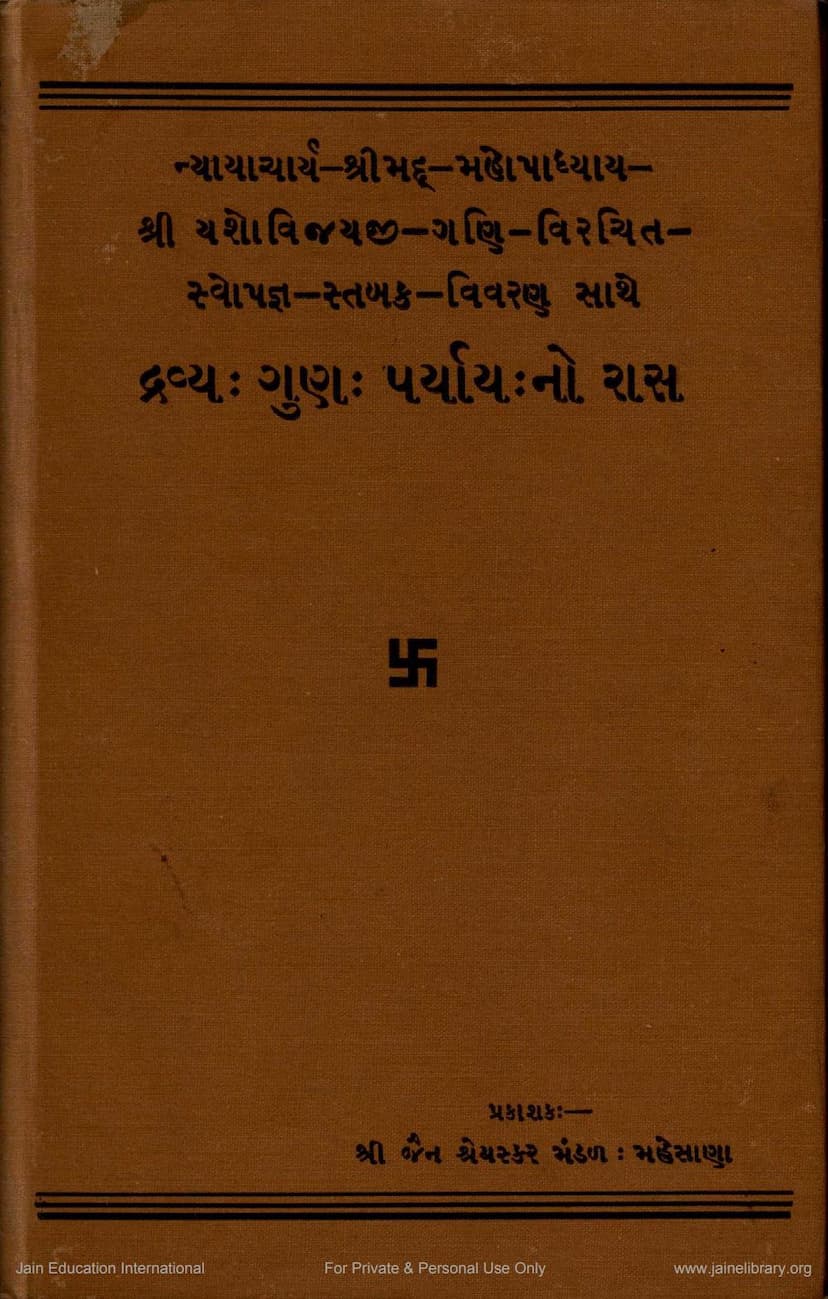Dravya Gun Paryaya No Ras
Added to library: September 1, 2025

Summary
Certainly, here is a comprehensive summary of the Jain text "Dravya Gun Paryaya no Ras" by Yashovijay Upadhyay, based on the provided pages:
Book Title: Dravya Gun Paryaya no Ras (A Composition on Substance, Qualities, and Modes)
Author: Acharya Shrimad Yashovijayji Ganvirachit (Composed by Acharya Shrimad Yashovijayji Ganvir)
Publisher: Shri Jain Shreyaskar Mandal, Mehsana
Summary:
The book "Dravya Gun Paryaya no Ras" is a Jain philosophical text composed by the esteemed scholar Acharya Yashovijayji. It delves into the fundamental concepts of Dravya (Substance), Gun (Quality), and Paryaya (Mode) within Jainism. The work aims to elucidate these core principles of reality according to Jain philosophy.
Key Aspects and Content:
-
Author and Publisher: The text is authored by the highly respected Acharya Yashovijayji Upadhyay, a renowned Jain scholar and philosopher. It was published by the Jain Shreyaskar Mandal in Mehsana. The first edition was published in Vir Samvat 2464 (1938 AD).
-
Purpose and Scope: The "Ras" (composition/poem) aims to explain the complex concepts of Dravya, Gun, and Paryaya, which are central to understanding the Jain ontological framework. It seeks to make these profound philosophical ideas accessible to seekers of knowledge.
-
Structure and Methodology:
- Composition Style: The text is presented in a poetic, rhyming "Ras" format, which is common in Jain literature for conveying spiritual and philosophical teachings in an engaging manner.
- Scholarly Foundation: The work is based on a rigorous scholarly approach. The editors, from Shri Jain Shreyaskar Mandal, undertook extensive research and comparison of four different handwritten manuscripts to prepare the published version. They also referenced printed Jain texts like "Dravyānuyog" and "Prakarna Ratnakara" for comparative analysis.
- Preservation of Language: The editors strove to maintain the original language and style of the author, Yashovijayji, making minor adjustments for clarity and consistency where necessary, especially concerning grammatical nuances of the time.
- Facilitating Understanding: To aid comprehension, the text incorporates additions of signs and symbols at various points. This is crucial for understanding the intricate logical arguments and the interconnectedness of sentences in a text rich with philosophical reasoning and concise expressions. The goal was to make the difficult subject matter more accessible to students.
- Extensive Index and Appendices: The book includes a detailed index of topics covered in each chapter (Dhal), and several supplementary essays are included. These essays provide insights into modern concepts like Dravya, Kshetra, Kala, and Bhava from a Jain perspective, aiming to stimulate the reader's intellect and reasoning power.
-
Philosophical Concepts Explained:
- Dravya (Substance): The text discusses the nature of substance, which is eternal and the underlying reality of existence, unaffected by change.
- Gun (Quality): Qualities are the inherent characteristics of a substance that exist eternally with the substance. They are inseparable from the substance.
- Paryaya (Mode/State): Modes are the transient changes or states that a substance undergoes. They are the modifications of the substance, caused by various factors.
- Interrelation of Dravya, Gun, and Paryaya: A significant portion of the text is dedicated to explaining the relationship between these three fundamental concepts. It clarifies how a substance remains the same while undergoing changes in its modes, and how qualities are its permanent attributes. The text likely uses examples and analogies to illustrate these complex relationships.
- Naya (Standpoints): The book extensively explores the concept of Nayas (standpoints) in Jain philosophy. It discusses various Nayas, such as Dravyarthik Naya (viewpoint of substance) and Paryayarthik Naya (viewpoint of modes), and how they help understand reality from different perspectives. The text delves into the Shvetambara and Digambara perspectives on Nayas, including discussions on the twenty-eight Nayas and the seven Nayas.
- Syadvada and Sapta-bhangi: Given the exploration of Nayas, the text likely also touches upon Syadvada (the doctrine of conditioned predication) and Sapta-bhangi (the seven-fold prediction), which are crucial for reconciling seemingly contradictory viewpoints about reality.
-
Author's Expertise and Background: The introduction emphasizes Yashovijayji's profound knowledge and devotion to Jain philosophy, Jain Acharyas, Agamas, and the Tirthankaras. His rigorous study, including in Kashi, earned him the title "Nyayavisharad" (expert in logic). His approach is described as comprehensive, well-reasoned, and capable of refuting other philosophical systems while highlighting the eternal beauty and depth of Jain thought.
-
Relevance to Modern Science: The text also makes a point about the enduring relevance of Jain philosophy, suggesting that if Yashovijayji were alive today, he could even engage with modern scientists, potentially demonstrating the limitations of purely empirical scientific methods when dealing with phenomena beyond direct observation, such as the workings of the heart or inherited traits. It implicitly argues that Jain philosophy, with its emphasis on subtle truths and logical reasoning, offers a comprehensive worldview that can even complement or critique modern scientific understanding.
In essence, "Dravya Gun Paryaya no Ras" is a foundational text that systematically explains the core ontological categories of Jainism. It combines philosophical depth with poetic expression, aiming to provide both intellectual and spiritual nourishment to its readers. The detailed index and scholarly editing make it a valuable resource for students and scholars of Jain philosophy.